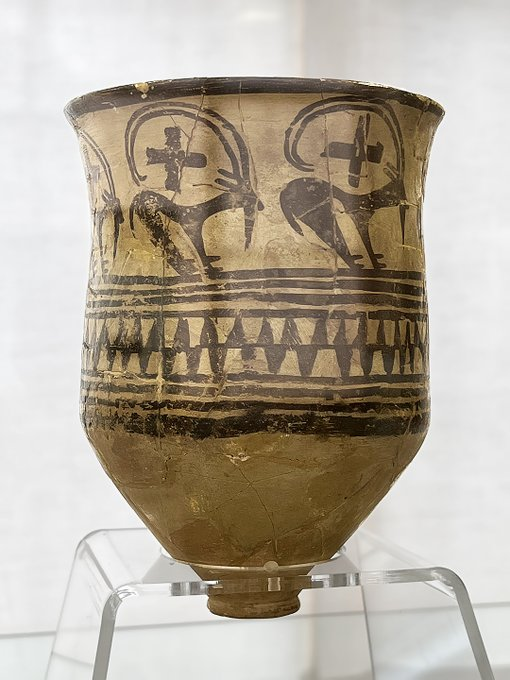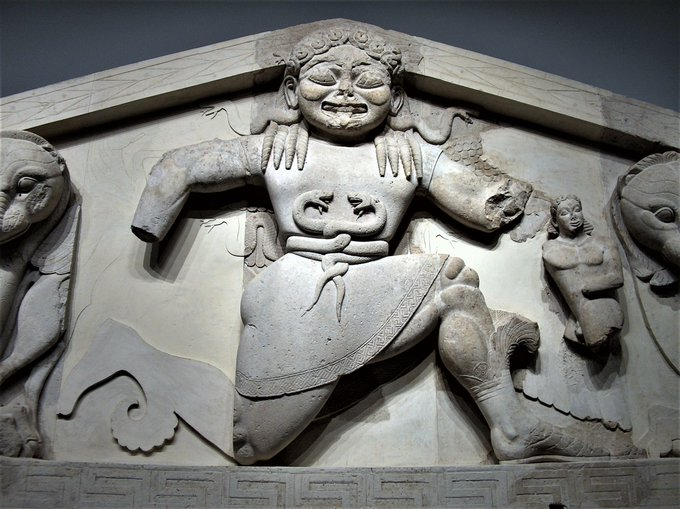Boeotian clay pyxis depicting the "Mistress of the Animals and some animals"; Late 7th century BC. Currently in the Antikensammlung Berlin
You see, it is because of "some animals" that we have no idea what most of our archaeological artefacts mean...
These are not some random animals. They are all solar symbols.
On the lid we see two snakes.
Snake is a pure solar animal. It is in our world when sun is here (day, hot half of the year) and it is in the underworld when sun is there (night, cold half of the year)...I first talked about it in these posts: "The chthonic animal" and "Enemy of the sun", but have since then talked about "solar snakes" in many other posts, like "Letnitsa treasure", "Nude winged hero dominating snakes" "Mystery seal", "Snake god from Hatra", "Goat and snake from Kortik tepe", "Goat petroglyphs from Iran", "Pegasus and Chimera"...
Even more interestingly, two snakes have a specific meaning as a calendar marker for Apr/May, beginning of summer, domain of the sun. Why? Cause the mating season of the most common Eurasian snakes starts in Apr/May...
And which is why Hermes (who was born in Apr/May) was by Apollo (the sun god) given the Caduceus, staff with two entwined snakes...I talked about this in my post "Lyre of Apollo"
Between the two snakes we see crosses...I talked about crosses as ancient solar symbols in my post "The cross of Shamash" about this beaker, Sialk South Mound, Kashan, Isfahan, Late Calcolithic period, Sialk III7 period, ca. 3750-3350 BC, the National Museum of Iran, Tehran, Iran
In short, the cross was since the earliest times in Mesopotamia used as the symbol for the sun (god)...
And on both sides of the two snakes we see swastikas, another ancient solar symbol. I talked about it in my post "Kolo-vrt", about this ancient (officially medieval???) standing stone, Bosnia. Depicting solar wheel (swastika) and solar dance (kolo)... Pic by Kemal Čolak...
Anyway, on the sides of our pyxis, we have more swastikas, crosses and horses...Why horses?
Horses are solar animals.
Roman silver coin of the Pyrrhic war (275-270 BC) Apollo wears a laurel- wreath & a galloping horse beneath the "star". Thanks @HawkeJon for the pics.
The "star" is The Sun...Above The Solar Horse...Symbol of The Sun God Apollo...
And articles about solar horse (equid):
Mesopotamia "Shamash playing with the solar horse"
India "Hayagriva"
China "Longma"
Europe "Archaic rider"
The reason why equids are solar animals and the reason why they are linked with Sun gods, stems from the fact that horse fertility is governed by sunlight and their mating season peaks at the summer solstice...
Sun god in his horse drawn chariot...
Finally, the "Mistress of the Animals" is Artemis, the "terrible" twin sister of the "terrible" sun god Apollo...This girl: Artemis, of the original, archaic type, before people forgot her real meaning...From the Temple of Artemis, Corfu
Definitely not moon goddess here with all these snakes. And lions (wink wink, notch notch)
On our pyxis, the Winged Archaic Artemis is holding two ducks or gees...Both migratory water birds...Spring bird migration in Greece peaks during late April-early May...
The "rosettes" are another symbol of the sun...Or Sirius...Which is in the sky with the sun, during the day, between Apr/May and Jul/Aug. At least it was during the time when our mythologies were made. Will write about this soon...
But it could also just mean "spring flowering season" which in Greece also peaks in Apr/May...
Soooo...Not only are all the symbols on this Larnax solar symbols, but they also all seem to point at the same time of the year, Apr/May, beginning of summer...
To read more about ancient animal and plant calendar markers, start here…then check the rest of the blog posts related to animal calendar markers I still didn't add to this page, and finally check my twitter threads I still didn't convert to blog post...I am 9 months behind now...
























